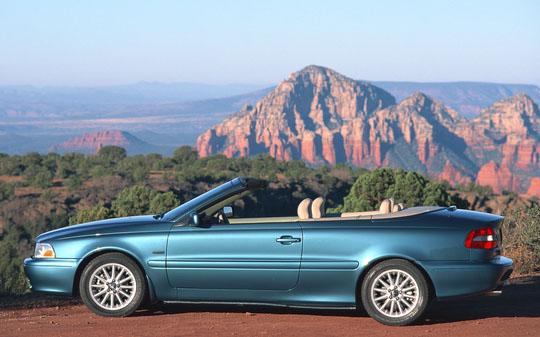 |
|
The Saint's Volvo ConvertibleBy Dan BodenheimerThe Saint's relationship with Volvo has been steadfast over the years. The white Volvo P1800 that Roger Moore drove in The Saint television series has become a cultural icon, easily recognized the world over as The Saint's car. With the new Volvo C70 coupe, The Saint's relationship with Volvo has been renewed. But what if The Saint wanted to drive a convertible? The Saint's first car, the mighty and mythical Hirondel, was certainly a roar-in-the-ears open-top that had a certain knack of being under him when he jumped from a soaring biplane.
Knowing this, it is certainly a shock to see the words, "Volvo" and "convertible" next to each other in a sentence. An image of a perfectly flat box comes immediately to mind, probably followed by a brief chuckle. Not an image that will make the average car enthusiast go running for their nearest auto dealer. Volvo's are safe family cars, and the thought of them making a convertible just adds to the already abundant confusion of life. Would it then surprise you to know that the very first Volvo was a convertible, and that there were others too?
The Volvo "Jakob" OV4
Interestingly enough, the first OV4 proved to be even more robust than Volvo anticipated. When it came time to roll off the assembly line, it was found that "Jakob" had three reverse gears! Talk about over engineering! On the other hand, there was only one forward gear, and it was quickly discovered that in their excitement, the rear differential (that had only arrived the evening before) had been installed upside down. Ten minutes later, the axle was turned over, and the first Volvo was out and about on its initial test run. Luckily for The Saint that he wasn't around in 1927, for this Volvo was much too utilitarian for his adventurous lifestyle. A saloon version (with roof) of the new Volvo was soon after introduced as the PV4, and it quickly became clear that most Swedish buyers preferred enclosed vehicles so they could enjoy year-round motoring. Volvo's convertible would have to wait for another market in order to be seen in quantity.
The Norrmalm PV655
Almost a one-of-a-kind, this car originally had a twin which was built for a court jeweler, also in Stockholm, in the Autumn of 1933. Unfortunately, the second Norrmalm PV655 has completely disappeared, probably a victim to the harsh climate and World War II that its sister narrowly survived (although not unscathed). Now exquisitely restored, the Norrmalm PV655 survives as a unique testament to Swedish engineering and taste of the 1930's.
The Nordbergs PV51
These custom PV51 convertibles were built in 1937, and added to the Nordbergs' already high esteem in the coach-building industry. The cars were of exceptional quality, and Nordbergs went on to create custom open-top's of the PV61 and PV445 as well.
The Volvo "Volvosport" P1900
The end came when Gunnar Engelau, then Managing Director of Volvo, took a P1900 out for a 447 mile weekend trip. He was extremely displeased with the quality standards, and in 1957 after only 68 cars had been built, the entire project was scrapped.
The Volvoville P1800
That didn't stop some dealers, however, from modifying their stock of 1800's. Volvoville of Long Island, New York, became the most famous when they offered a dealer-installed option of a roofless P1800. The dream of Volvoville's founder, Stanley Lazrus, the Volvoville P1800 convertible was built using tops supplied by a local boat builder. The first was built in 1964 using a 1963 model, with about 30 more of these custom-made convertibles being ordered before Volvoville canceled the option in 1969. Many other owner-modified 1800's have been created, with the most common soft-top being from a cousin of the 1800, the Volkswagen Karmann Ghia.
The Volvo C70 Convertible
Two things are clear: Volvo's new C70 coupe lends itself extremely well to an open-top version, and the technology of the 1990's means that no compromises need be made. The C70 coupe is a sporty car for the sophisticated driver, and with the advent of the C70 convertible Volvo's open-top dream becomes a reality. Today's safety advances in automobile engineering far surpass the constraints of the 1960's, and enable a convertible to be built that will stand up to the high safety demands of Volvo. The new C70 convertible features automatic rollover hoops that pop up, seat belt pre-tensioners to reduce slack, Boron steel reinforced A-pillers, front and side airbags, and a sophisticated safety cage that surrounds the passengers, making the Volvo C70 the safest convertible in the world.
|
Watch for the sign of The Saint, he will be back. | ||
|
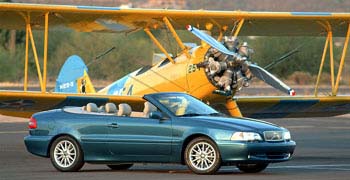
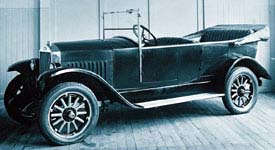 Yes
indeed, Volvo's first car, the "Jakob" OV4, rolled off the
assembly line on April 14th, 1927 without a roof. A fairly
straightforward design, the OV4 was a well-built car with an
emphasis on quality. This touring car's designation, OV4, came
from Öppen Vagn (open-top) and the number of cylinders.
Yes
indeed, Volvo's first car, the "Jakob" OV4, rolled off the
assembly line on April 14th, 1927 without a roof. A fairly
straightforward design, the OV4 was a well-built car with an
emphasis on quality. This touring car's designation, OV4, came
from Öppen Vagn (open-top) and the number of cylinders.
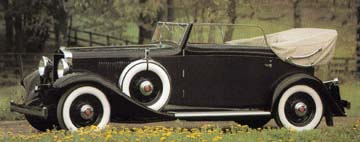 In
the meantime, Coach-builder Karosseriaktiebolaget Norrmalm used
the rugged Volvo PV655 chassis (also used in the PV653 and PV654)
to build this wonderfully elegant custom Volvo in 1933. This
tremendously Saint-worthy cabriolet features sleek lines, and a
beauty not found in many other Volvos. Specially built to the
exacting specifications of lady in Stockholm, the body was
skillfully tailored to bring the somewhat boring PV654 to life as
a rich open-top speedster.
In
the meantime, Coach-builder Karosseriaktiebolaget Norrmalm used
the rugged Volvo PV655 chassis (also used in the PV653 and PV654)
to build this wonderfully elegant custom Volvo in 1933. This
tremendously Saint-worthy cabriolet features sleek lines, and a
beauty not found in many other Volvos. Specially built to the
exacting specifications of lady in Stockholm, the body was
skillfully tailored to bring the somewhat boring PV654 to life as
a rich open-top speedster.
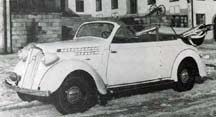 Gustaf
Nordbergs Vagnfabrik AB of Sweden also built a number of special
custom Volvos using various different chassis designs. On occasion
the Nordbergs body would be completely different, but in the case
of the PV51 only minor changes were made. The first of which was
that the roof was removed to make yet another Volvo convertible.
Gustaf
Nordbergs Vagnfabrik AB of Sweden also built a number of special
custom Volvos using various different chassis designs. On occasion
the Nordbergs body would be completely different, but in the case
of the PV51 only minor changes were made. The first of which was
that the roof was removed to make yet another Volvo convertible.
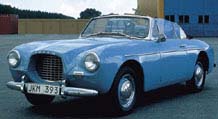 Years came
and want, and finally in 1956 Volvo was ready to really open up
the American market. Their PV444 was already selling well, and it
gave Volvo an extremely solid reputation with which to introduce a
nifty new sports car. Aimed to compete with the Corvette, the
Volvo "Volvosport"
Years came
and want, and finally in 1956 Volvo was ready to really open up
the American market. Their PV444 was already selling well, and it
gave Volvo an extremely solid reputation with which to introduce a
nifty new sports car. Aimed to compete with the Corvette, the
Volvo "Volvosport" 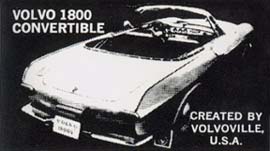 When
Volvo designed the P1800, they purposely made the doors without
solid frames around the windows. This was done so that they could
eventually come out with a convertible version with as little
trouble as possible. Unfortunately, the Volvo engineers of the
1960s were given a hurdle that they could not overcome. Safety was
now the name of the game, and the technology of the 1960's was
just not up to the task. There was no way of making a convertible
safe enough to pass Volvo's tough new safety regime.
When
Volvo designed the P1800, they purposely made the doors without
solid frames around the windows. This was done so that they could
eventually come out with a convertible version with as little
trouble as possible. Unfortunately, the Volvo engineers of the
1960s were given a hurdle that they could not overcome. Safety was
now the name of the game, and the technology of the 1960's was
just not up to the task. There was no way of making a convertible
safe enough to pass Volvo's tough new safety regime.
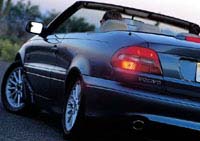 With
the 1997 launch of the first Volvo sports coupe since the P1800,
Volvo has dramatically entered a new era. The new C70 is a
compelling car for people who love to drive, and the most telling
testament to it is the often heard saying, "that is a Volvo?"
With
the 1997 launch of the first Volvo sports coupe since the P1800,
Volvo has dramatically entered a new era. The new C70 is a
compelling car for people who love to drive, and the most telling
testament to it is the often heard saying, "that is a Volvo?"
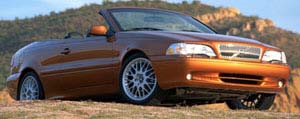 Volvo's
marketing and reputation has established their name firmly in the
hearts of the safety conscious, but now you can have both the car
that you "have to drive' as well as the car "you want to drive"
all in one beautiful Volvo C70 convertible. The new Volvo
convertible is a car for all your senses, including common
sense--something you'll need when the wind is blowing through your
hair at 146 miles per hour. Now that is a convertible truly suited
for The Saint.
Volvo's
marketing and reputation has established their name firmly in the
hearts of the safety conscious, but now you can have both the car
that you "have to drive' as well as the car "you want to drive"
all in one beautiful Volvo C70 convertible. The new Volvo
convertible is a car for all your senses, including common
sense--something you'll need when the wind is blowing through your
hair at 146 miles per hour. Now that is a convertible truly suited
for The Saint.
